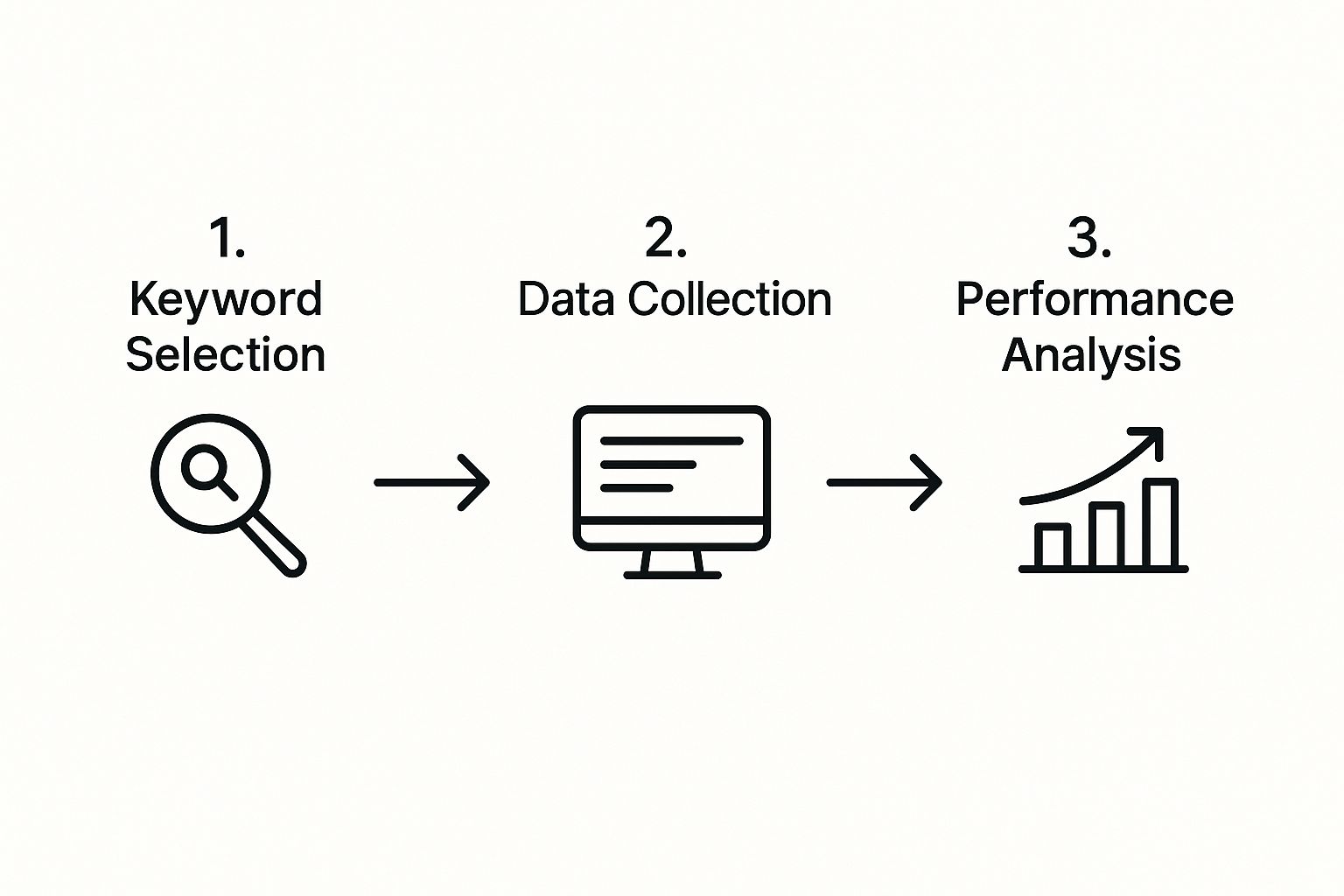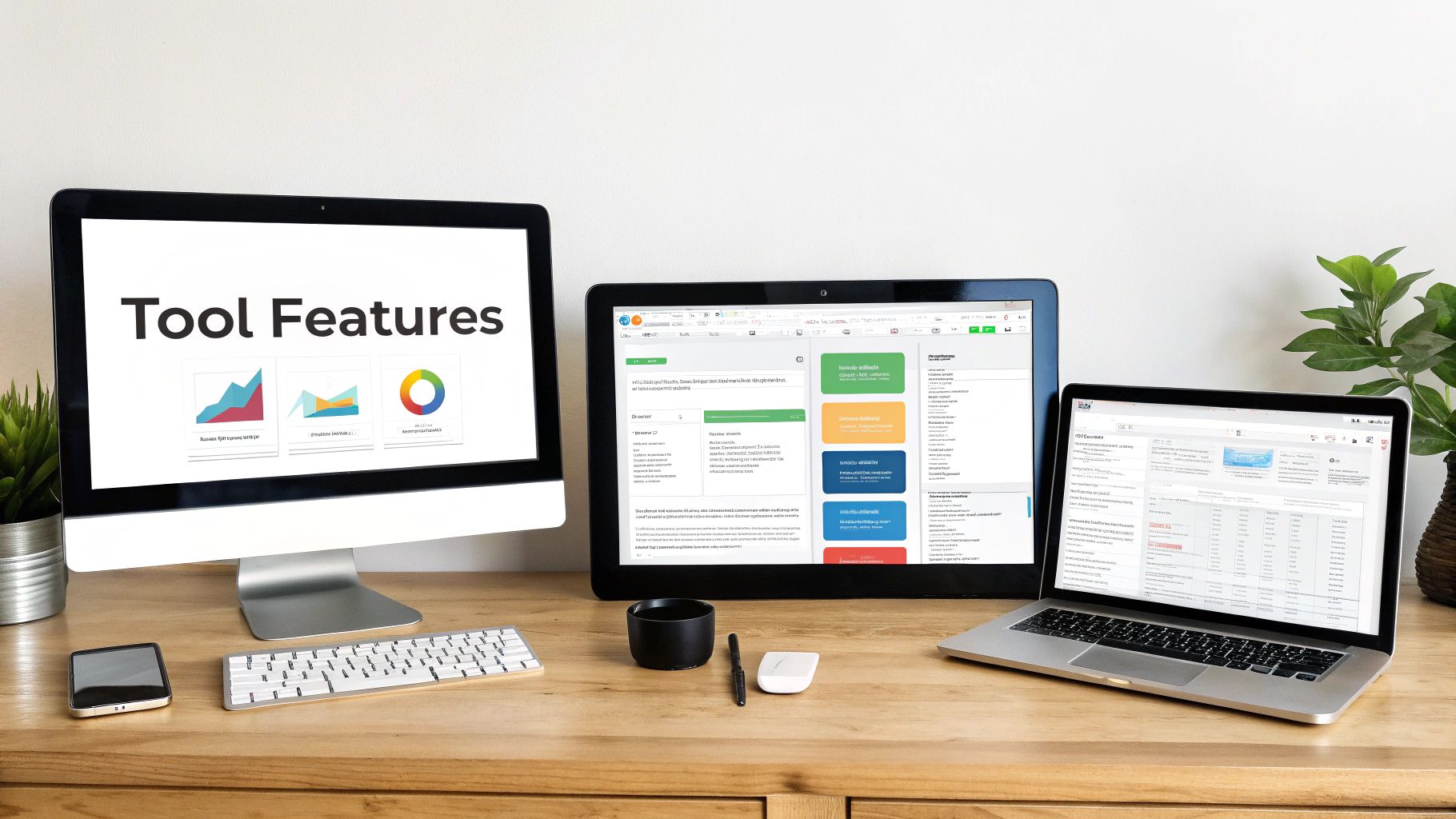Think of rank tracking as your SEO report card. It's the simple, ongoing process of checking where your website shows up on search engine results pages (SERPs) for the specific keywords that matter most to your business. It tells you exactly where you sit on the massive "digital shelf" that is Google.
What Is Rank Tracking and Why It Matters

Can you imagine running a brick-and-mortar store but never checking your inventory? Or never looking at how your products are actually displayed on the shelves? You'd have no idea what's selling, what's collecting dust, or how you compare to the shop next door.
Trying to do SEO without rank tracking is the digital equivalent of that. You're essentially flying blind.
At its heart, rank tracking gives you the hard data you need to stop guessing and start making smart, informed decisions. It’s not about ego or chasing vanity metrics; it's about strategy.
The Strategic Value of Knowing Your Position
Seeing that you rank #7 for a keyword like "best running shoes for beginners" tells you so much more than just a number. It’s a direct signal of how well your content is resonating with what people are searching for and how you’re holding up against your competitors.
This information is the bedrock of any solid organic growth plan. It helps you:
- Measure SEO Performance: You can directly connect the dots between your content updates, new backlinks, or technical fixes and your actual movement in the search results.
- Spot Quick-Win Opportunities: Find those keywords hovering on page two or three. A simple content refresh or some internal linking could be all it takes to push them onto page one for a significant traffic boost.
- Analyze Your Competition: Keep an eye on where your rivals are ranking. This helps you deconstruct their strategy, spot weaknesses, and uncover keywords you might have missed entirely.
By consistently tracking your rankings over time, you build a historical performance log. This record is pure gold for diagnosing sudden ranking drops, connecting your site's performance to Google algorithm updates, and proving the long-term ROI of your SEO efforts to clients or your boss.
Ultimately, rank tracking is the diagnostic tool that keeps your entire SEO engine running smoothly. To get the full picture, it’s also helpful to understand related practices like SEO content tracking, which ensures you're not just publishing content, but publishing content that actually performs.
How Rank Tracking Evolved with Google

To really get why rank tracking is so powerful today, you have to look back at how it started. It wasn't born overnight. Instead, it grew up right alongside Google, forced to change and adapt with every major shift in how search works. What started as a simple numbers game has become a surprisingly sophisticated diagnostic tool.
Back in the early days of the web, search results were the Wild West. Then, in 1998, Google launched PageRank, a system that brought order to the chaos by ranking sites on authority and relevance. This was the moment rank tracking became a real SEO practice. For the first time, SEOs had a concrete metric to aim for, turning the vague goal of "ranking higher" into something you could actually measure.
At first, the game was simple: do whatever it takes to get to the top. But as people got better at gaming the system, Google had to get smarter to protect the quality of its results.
The Era of Algorithm Updates
The game changed forever when Google started rolling out major algorithm updates. These weren't just small tweaks; they were earthquakes that shook the entire industry and forced everyone to rethink their strategies.
A few key updates completely redefined rank tracking:
- Google Panda (2011): This update went after sites with low-quality, "thin," or duplicate content. Suddenly, tracking your rank wasn't just about the number. It became a way to figure out if your content was the reason your visibility was tanking.
- Google Penguin (2012): This one penalized sites with spammy or manipulative backlinks. If your rankings dropped overnight, you couldn't just blame your content anymore; you had to investigate your entire link profile.
These updates proved that just knowing your rank was only half the story. The real work was understanding why it changed. Digging into the history of SEO shows just how much these events shaped the marketing strategies we use today.
Rank tracking went from simple scorekeeping to being an essential diagnostic tool. It became the EKG for your website’s health, letting you connect ranking drops to specific problems with your content or backlinks.
This history is so important. It shows us that modern rank tracking isn't about chasing a static number. It's about monitoring a living, breathing system and being ready to respond to whatever Google throws at you next. That’s why it’s a cornerstone of any serious SEO strategy.
Understanding How Rank Tracking Tools Work
So, what’s really going on behind the scenes when you use a rank tracking tool? The easiest way to think about it is like sending out a team of highly specialized "scouts." You give each one a very specific mission: go to Google, search for this exact keyword, pretend you're in London using an iPhone, and report back on where my website is ranked.
These scouts work in a completely sterile, anonymous environment. This part is absolutely critical. Why? Because your own Google searches are heavily influenced by your personal browsing history, your physical location, and your past clicks. Rank trackers strip all that away to give you a clean, objective view of where you stand. It's the difference between asking a buddy if they've seen your ad and getting a formal report detailing its exact placement and visibility.
Gathering Unbiased SERP Data
To get this pure, unbiased data, these tools send requests to search engines in a way that mimics a real person. They can simulate a search for your keyword from a desktop computer in New York and, at the same time, check how you rank for it on a mobile phone in Sydney. You get a global picture without ever leaving your desk.
During this process, the tool grabs the raw HTML code of the search engine results page (SERP). It then combs through that code to find what matters.
- Organic Rankings: The tool meticulously scans the results to pinpoint your site's exact numerical position.
- SERP Features: It also looks for special placements, like whether your content shows up in a Featured Snippet, Image Pack, or Video Carousel.
- Competitor Data: At the same time, it’s also logging where your competitors rank for that same keyword, which is invaluable intel.
This simple workflow is what makes it all tick.

This cycle of selecting keywords, collecting SERP data, and analyzing the results is the powerhouse behind all effective SEO reporting.
Ensuring Accuracy and Reliability
By automating this whole process, rank tracking tools can check thousands of keywords every single day. That’s a scale and precision that's simply impossible to replicate by hand. This consistency is what lets you track your progress with confidence, spot problems early, and make smart strategic moves based on solid data. If you want to dive deeper into the nuts and bolts, our guide on how to track keyword rankings has more detail.
For a great breakdown of different platforms, check out these Top 7 Tools for Niche Keyword Rank Tracking. Ultimately, this technology gives you peace of mind, knowing the numbers you're looking at reflect what your potential customers are actually seeing out there in the real world.
Measuring What Truly Matters in Rank Tracking

Knowing your keyword rank is the starting line, not the finish line. If you're only focused on whether you're number one for a single term, you're missing the forest for the trees. It’s like judging a movie by its poster—you get a tiny glimpse, but you miss the entire story.
To make truly smart SEO decisions that drive results, you have to dig into the metrics that paint the full picture. This means shifting your mindset from "Am I #1?" to asking more strategic questions. How much of the search conversation do I actually own? Are my most valuable rankings clustered at the top of page one? And which special SERP features am I winning?
Answering these questions requires looking at more sophisticated metrics. These data points give your rankings crucial context, helping you see not just where you rank, but how that position translates into real-world visibility and potential clicks. This is the difference between basic reporting and genuine strategic analysis.
Visibility Score and Share of Voice
One of the most insightful metrics you can track is Visibility Score, sometimes called Share of Voice. Think of it as your website's total market share in the search results for the keywords you care about. It’s a smart, weighted metric that correctly assumes a #1 spot is far more valuable than a #9 spot, because it gets exponentially more clicks.
A high score means you’re a major player for your target topics. For instance, if your Visibility Score is 35%, it means you're capturing roughly a third of all the estimated clicks available across your entire keyword list. Watching this number trend up over time is a fantastic sign that your overall SEO efforts are paying off.
A rising Visibility Score is a clear indicator that your SEO strategy is working on a macro level, even if individual keyword rankings fluctuate day to day. It smooths out the noise and shows true progress.
Position Distribution and SERP Features
Another goldmine of insight is your position distribution. This isn't about one keyword; it’s about the big picture. It shows you exactly how many of your keywords are landing in the most important ranking buckets:
- Top 3 Positions: The "money" spots. These coveted rankings capture the lion's share of clicks. An increase here is a massive win.
- Top 10 Positions (Page 1): This shows how many keywords are getting you on the board with meaningful visibility.
- Positions 11-20 (Page 2): I call this the "striking distance" list. These are keywords with huge potential that just need a little nudge—like a content refresh or a few new backlinks—to jump onto page one.
Of course, today’s search results are more than just a list of ten blue links. They're packed with rich results like Image Packs, Featured Snippets, and Local Packs. Your rank tracking absolutely must monitor these SERP features. Winning a Featured Snippet, for example, can launch you to "position zero" above the traditional #1 spot, dramatically boosting your click-through rate.
To help you get a handle on what to track, I've put together a quick comparison of the most important metrics.
Essential Rank Tracking Metrics Compared
This table breaks down key metrics, explaining what they measure and how you can use them to inform your SEO strategy.
| Metric | What It Measures | Strategic Insight |
|---|---|---|
| Average Position | The mathematical average of all your keyword rankings. | A high-level health check. A falling number is good, but it can be misleading if a few low-volume keywords improve. |
| Visibility Score | Your overall market share in the SERPs, weighted by position. | The best single metric for tracking overall SEO progress. Shows if your strategy is gaining or losing ground across all keywords. |
| Position Distribution | How many keywords you have in key ranking groups (e.g., Top 3, 4-10). | Helps you identify where your strengths and weaknesses are. Are you dominating or just getting on page one? |
| SERP Feature Ownership | How many rich results (Snippets, Image Packs, etc.) you've won. | Reveals opportunities to gain "position zero" rankings and capture more clicks, even without being the #1 organic result. |
By moving beyond simple rank checking and embracing these deeper metrics, you gain a much clearer and more accurate understanding of your real performance. You'll spot your best opportunities, diagnose problems faster, and make strategic choices that lead to measurable growth.
Putting Your Rank Tracking Data into Action
Collecting rank tracking data is a bit like gathering detailed blueprints for a house. The information is fascinating, but it only becomes a home once you start building. In the same way, the real magic of rank tracking happens when you turn those numbers and charts into a clear roadmap for improving your SEO performance.
This data lets you stop being a passive observer of your rankings and start actively shaping them. By looking at a few specific use cases, you can see how raw numbers are translated into strategic actions that get real results—and prove the value of your SEO work to everyone from your boss to your clients.
Conduct Powerful Competitive Analysis
One of the most immediate wins you can get from your ranking data is to turn the spotlight on your rivals. When you track the same keywords your competitors are going after, you can essentially reverse-engineer their entire content strategy.
Let's say you spot a competitor suddenly leap into the top three for a keyword you both covet. That’s your cue to dig in. A quick look at their ranking page can reveal the exact tactics that got them there. Did they add a video? Did they refresh their content with new statistics? Did they earn a few powerful backlinks? This intel gives you a proven playbook to copy and, more importantly, improve upon.
Rank tracking data is your secret weapon for competitive intelligence. It shows you which of your competitors' strategies are actually working in the real world, letting you learn from their successes and pounce on their weaknesses.
Validate Your Content Marketing Efforts
Ever publish a new blog post and cross your fingers, hoping it makes a difference? Rank tracking gives you a definitive answer. By tracking a new article's target keywords from the moment it goes live, you can watch its journey up the SERP ladder in near real-time.
Seeing a new piece climb from "not in the top 100" to page two, and then finally crack the first page, is concrete proof that your content strategy is on the right track. This data is gold when it comes to demonstrating ROI and getting buy-in for future content. And if you're looking for practical ways to accelerate that climb, our guide on how to improve search engine ranking is packed with actionable steps.
Diagnose Technical SEO Problems
Sometimes, the story your rank tracking data tells isn't a happy one. Imagine seeing an entire group of your key pages suddenly plummet in the rankings. That's almost never just bad luck; it’s a massive red flag signaling a technical problem, like an indexing error or an accidental "noindex" tag.
Without rank tracking, these kinds of issues could fly under the radar for weeks, quietly tanking your traffic. With it, you get an early warning system that tells you to investigate and fix the root cause before real damage is done. The historical data from rank trackers is especially powerful here. The industry has been tracking hundreds of millions of keywords daily since at least 2006, building a colossal dataset. This long-term view helps you spot gradual declines over months or pinpoint the exact day a sudden drop happened—giving you critical context you'd never get from just looking at a browser. To learn more about this rich history, you can explore detailed insights about competitor ranking data.
Navigating Modern Rank Tracking Challenges
Let's be honest: rank tracking isn't what it used to be. The days of simply checking a list of ten blue links are long gone. The search results page has become a dynamic, complex, and highly personalized space, which means we need a much smarter approach to tracking our performance. If you're still looking at a single, generic ranking number, you're only seeing a tiny fraction of the whole picture.
The Mobile-First Revolution
The biggest game-changer has been the massive shift to mobile. Since 2015, mobile searches have consistently outnumbered desktop searches. Because of this, Google officially moved to mobile-first indexing for all websites by 2021. This means Google uses the mobile version of your site to determine its rankings for all searches.
What does this mean for you? It means your mobile and desktop rankings can be wildly different. You might be celebrating a #1 spot on desktop while completely missing that you’re languishing at #5 on mobile—where most of your potential customers are actually looking. To understand just how much this has changed the game, check out this great resource on the evolution of SEO on WebFX.com.
Personalization and Localized Results
Adding another layer of complexity is personalization and localization. Google's goal is to give each user the most relevant result for them, so it rarely shows the same SERP to everyone. A person's physical location, their past search habits, and even the device in their hand can dramatically change the results they see.
Think about it: a search for "best Italian restaurant" will give you completely different answers in Chicago than it will in Rome. This is precisely why having a standardized, location-specific tracking method is non-negotiable. It cuts through the noise of personalization and gives you a stable, objective baseline to measure your actual performance.
Rank tracking tools act as your neutral, third-party observer. They give you the unbiased truth by simulating searches from specific locations and devices, ensuring the data you base your strategy on is consistent and reliable.
This neutral viewpoint is absolutely critical. For any brand trying to reach a national or even global audience, you have to know how you're performing in different regions. To stay on top of these constant, subtle shifts, many professionals rely on frequent checks. In fact, our own guide on daily rank tracking digs into why this frequency is so valuable in today's fluid environment.
The Ever-Changing SERP Landscape
Finally, the very definition of a "#1 rank" has been turned on its head. Today’s search results are packed with eye-catching features that all compete for user attention and, more importantly, their clicks.
We’re talking about things like:
- Featured Snippets that answer a user's question right at the top of the page.
- "People Also Ask" boxes that expand to take up more and more screen real estate.
- Image and Video Carousels that push the traditional organic results further down the page.
Your website could be the top organic blue link but still be pushed "below the fold," buried under a mountain of these other elements. True, effective rank tracking today has to account for this reality. It's not just about monitoring your blue-link position anymore; it's about tracking your presence and visibility across all of these valuable SERP features.
Got Questions About Rank Tracking? We've Got Answers
Even after you've got the basics down, some practical questions always pop up when you start putting rank tracking into action. Let's tackle a few of the most common ones I hear from people just starting out, so you can move forward with confidence.
How Often Should I Actually Check My Keyword Rankings?
This is probably the number one question people ask, and honestly, it depends. There's no single right answer, but there are best practices.
For most businesses, especially if you're in a competitive space, daily tracking is the gold standard. It lets you catch things almost as they happen—a big Google update, a competitor making a move, or a technical glitch on your own site. That kind of real-time feedback is invaluable for staying agile.
If daily tracking feels like overkill or you're working with a smaller site or budget, weekly checks are a perfectly solid alternative. You'll still see the important long-term trends and get a good sense of whether your SEO efforts are paying off, but you won't get bogged down by the tiny, meaningless daily wiggles.
What really matters is consistency. Pick a schedule, whether it's daily or weekly, and stick with it. That's how you build the historical data you need to spot real patterns and make smart decisions.
Can I Just Track My Ranks Manually Without a Tool?
You could, in theory. People try this by opening an incognito browser window and Googling their keywords. But for any serious SEO work, this approach is a trap. It's incredibly tedious, wildly impractical, and worst of all, the data you get is just plain wrong.
Even when you're in incognito mode, Google still uses your physical location and other subtle signals to personalize your results. A real rank tracking tool sidesteps all of that. It gives you clean, unbiased data from any location you want, for thousands of keywords at once. It’s the difference between guessing based on a flawed snapshot and making strategic moves based on reliable intelligence.
Help! My Rankings Look Different Than What My Tool Is Reporting.
Don't panic! This is completely normal and, frankly, expected. It's the whole reason we use these tools in the first place.
When you Google something yourself, the results you see are custom-made for you. Google knows your location, your search history, the device you're on, and it uses all that to serve up a unique SERP.
A rank tracking tool, however, works by creating a clean-slate, standardized search. It pretends to be a brand new user searching from a specific place (say, Chicago, IL on an iPhone) to give you a stable, consistent benchmark. That objective viewpoint is what you need for genuine SEO analysis, not the personalized one you see on your own screen.
Ready to get a clear, unbiased view of your SEO performance? With That's Rank, you can monitor your keywords, audit your site, and track competitors with precision. Start tracking your rankings for free today and turn data into growth.
Related Articles
12 Best Ecommerce SEO Tools to Boost Sales in 2025
Discover the 12 best ecommerce SEO tools to skyrocket your online store's visibility. In-depth reviews to help you track rankings and grow revenue.
How to Find Website Rank Without Breaking the Bank
Master how to find website rank using proven methods that won't cost you thousands. Real tactics from marketers who've tracked rankings for years.